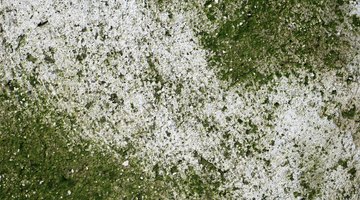How to Remove Algae From Concrete
Algae thrives in moist, cool areas such as shaded walkways and home foundations. Concrete and other porous building materials are prone to algal growth because they hold moisture, providing an ideal environment for them to grow.

Algae is not only unsightly and damaging to the concrete it colonizes, it also poses a significant safety hazard due to its slippery texture. Removing algae from concrete requires a significant time investment because it is tenacious and may return during moist, rainy weather. However, it is possible to eliminate the unwanted growth using a combination of manual removal and non-toxic chemical solutions.
Things You Will Need
- Wire brush or shop broom
- Long-handled scraper
- Goggles
- Pressure washer
- Rubber gloves
- Oxygen bleach
- Non-metallic bucket
- Borax
- Washing soda
- Dishwashing liquid
- Hand-pump sprayer
- Pruning shears (optional)
-
Scrub the concrete with a wire brush or a stiff-bristled shop broom to loosen the algae and remove any large, cohesive pieces. Go over the surface several times until most of the algae is lifted and only the sub-surface stains remain. Scrape up the loosened algae with a long-handled scraper and discard it.
-
Put on protective eyewear such as goggles. Spray down the stained concrete surface with a pressure washer to lift any slippery, viscous material left behind by the algae. Brush the algae-tainted water left behind to a sunny area where it will evaporate.
-
Put on rubber gloves. Combine 5 parts warm water and 1 part oxygen bleach in a non-metallic bucket, or combine 1 gallon water, 1/2 cup borax, 1/2 cup washing soda and 1 tablespoon dishwashing liquid in a non-metallic bucket. Use the oxygen bleach solution to treat the algae if plants are growing nearby because it is less likely to damage them.
-
Stir the solution with a wooden spoon or stick until the dry ingredients dissolve. Pour the solution into a hand-pump sprayer. Use the solution immediately because it will lose efficacy after a few hours.
-
Spray the cleaning solution onto the algae-stained concrete until it is saturated. Treat the area immediately surrounding the algal growth, as well, to prevent its spread. Let the solution soak in for at least 10 minutes, rewetting the area as needed to keep it saturated.
-
Scrub the area again with a shop broom or wire brush to lift and remove any remaining algae. Rinse the area with the pressure hose as before, then brush off the excess liquid with a shop broom so the surface can dry off quickly.
-
Treat the area with the cleaning solution biweekly until the algae is gone. Prune back any overhanging shrubbery to improve air circulation in the area and reduce shading. Brush the concrete vigorously with a shop broom each week to keep any newly formed algae from taking hold.
Tip
Sealed concrete is less permeable and therefore less likely to host algae. Correct any nearby water leaks and redirect gutters to release water away from concrete surfaces to help prevent algal growth.
Warning
Avoid prolonged contact with oxygen bleach, washing soda and borax; although not toxic, they can cause skin irritation in sensitive individuals. Avoid using detergents when cleaning outdoor concrete; they contain phosphates that nourish algae.
The Drip Cap
- Algae thrives in moist, cool areas such as shaded walkways and home foundations.
- Put on protective eyewear such as goggles.
- Use the oxygen bleach solution to treat the algae if plants are growing nearby because it is less likely to damage them.
- Treat the area with the cleaning solution biweekly until the algae is gone.
References
- Royal Horticultural Society: Algae, Lichens, Liverworts and Moss on Hard Surfaces
- University of California Cooperative Extension: Moss and Algae in Lawns, Roofs and Walkways
- Chicago Tribune: Oxygen Bleach Removes Algae Without Toxicity
- Utah State University Cooperative Extension: 5 Cleanup Solutions for Your Home Exterior
Writer Bio
Samantha McMullen began writing professionally in 2001. Her nearly 20 years of experience in horticulture informs her work, which has appeared in publications such as Mother Earth News.
Photo Credits
- Letizia Tomasso/iStock/Getty Images
- Letizia Tomasso/iStock/Getty Images
More Articles



